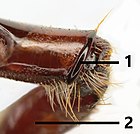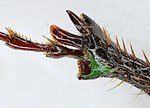Aplidia transversa
| Aplidia transversa | ||||||||||||
|---|---|---|---|---|---|---|---|---|---|---|---|---|

Aplidia transversa |
||||||||||||
| Systematics | ||||||||||||
|
||||||||||||
| Scientific name | ||||||||||||
| Aplidia transversa | ||||||||||||
| ( Fabricius , 1801) |
Aplidia transversa (also Haplidia transversa ) is a beetle from the family of scarab beetles , the subfamily of melolonthinae and the tribe Rhizotrogini. The genus Aplidia is represented in Europe with seven species , the species Aplidia transversa occurs in three subspecies.
Notes on the name
The beetle was first described by Fabricius in 1801 under the name Melolontha transversa . The description contains the sentence: clypeo reflexo: linea elevata transversa (Latin: head shield bent upwards , with a raised transverse line ): the species name refers to the transverse ridge on the forehead, which can be found in all species of the genus.
To counteract the confusion of scientific names that threatened in the early days of coleopterology , Hope published a handbook in 1837 in which he compared the names of scarab beetles used by Linnaeus and Fabricius in the form of lists with the names used by younger coleopterologists. One of these lists shows that the Melolontha transversa by Fabricius was placed in the new genus Aplidia in an unpublished manuscript by Kirby . The generic name Aplídia is from Altgr. ἁπλóος (haplóos, simple) and ιδέα (idéa, shape) derived. The correct transcription of ἁπλóος into the Latin script is because of the spiritus asper "haplóos", which is why Kraatz changed the name Aplidia to Haplidia . In more recent catalogs, however, the spelling of Hope is used again. The name refers to the fact that the beetle does not have any noticeable body features.
Properties of the beetle
Aplidia transversa usually reaches a body length of fourteen to seventeen millimeters, the females are up to twenty millimeters long. The beetle looks like a small cockchafer, the body is slightly expanded towards the back. The beetles are red-brown to black-brown, the underside more reddish (Fig. 1). The females are shiny and on average slightly darker than the males, sometimes almost black. The males are less shiny. Freshly hatched animals can have whitish tires.
The head shield is upturned and has a shallow edge (tinted yellow on the right in Fig. 4). A smooth-edged cross bar runs across the forehead (red traced in Fig. 4 on the right). The red-brown antennae are ten-segmented with a three-leaved club (Fig. 5). The leaves of the club are relatively short, only slightly longer in the males than in the females. The eyes are as common in night-active mammals, large. The head is roughly dotted up to the forehead . The upper lip has the shape of a croissant (Fig. 4 tinted green). It is not fused with the head shield, but is covered by the head shield when viewed from above. The upper jaw has a file-like grooved grinding surface (Fig. 3) and a longitudinal, chisel-like cutting edge. The cutting edges of the upper jaw meet like a nail clipper . The jaw probes are four-membered with an elongated spindle-shaped end member that has a longitudinal furrow on the upper side (arrowhead in Fig. 2, also recognizable in Fig. 4, left picture). The last link of the three-part lip probe is directed inwards, slender, slightly curved and pointed (tinted pink in Fig. 4).
The pronotum is much wider than it is long, and hairy close-fitting. In contrast to the other European species of the genus, the hairs are not upright in front of the tag (Fig. 7). The pronotum is dense and finely dotted, the sides finely notched (Fig. 6). On the front edge there are individual long straight hairs. In Aplidia transversa cretica , the puncturing is coarse and irregular.
The label is broadly triangular. The puncture is sparse and coarser than that of the pronotum.
The elytra are more roughly punctured. The first, third and fifth intervals are only inconspicuously raised like ribs. In the nominate form Aplidia transversa transversa , the hairs are significantly shorter than the distance between the points (Fig. 9), in Aplidia transversa peleponnisica they are as long as the distance between the points.
The tarsi of all legs are five-limbed. The claws of the claw pairs are of the same length, not the inner one longer than the outer one. Each claw has a strong, downward-pointing tooth in front of the center (Fig. 12). The front legs are designed as grave legs with three external teeth. The front hips are equipped with a transverse keel in front of the tip (No. 1 in Fig. 11). However, this is only clearly visible when the hips are turned so that the fore legs point backwards. All rails end with two end pins. The rear rails are trimmed and thus form a surface (insertion surface) into which the tarsi are deflected. The insertion surface is not evenly bordered, but is notched forward in a short groove (tarsal furrow, tinted green on the right in Fig. 13) into which the base of the hind tarsi can be inserted. The two movable terminal spines are turned in close to each other next to the turning of the tarsi. The outside of the rear rail has several sharp saw teeth (blue arrows in Fig. 10), the inside approximately in the middle with a stronger tooth (green arrow in Fig. 10). The rear hips are provided with a tooth protruding downwards on the inside at the front.
The chest is woolly, long and hairy whitish-gray (Fig. 1). The abdominal segments of the abdomen are fused together. No broad synovial membrane can be seen between the 5th and 6th abdominal segments (Fig. 8).
biology
The beetles often swarm en masse in late June or early July when it gets dark on various bushes, deciduous and coniferous trees. The swarming time can be limited to about half an hour, before and after no more beetles can be found. Both sexes are attracted to light sources. During the day, the beetles can be found hidden under stones.
distribution
The occurrence of the subspecies Aplidia transversa cretica is limited to Crete , that of Aplidia transversa peloponnesica to the Peloponnese . The distribution area of the nominate form Aplidia transversa transversa has its center in eastern southern Europe. The northern border of the distribution area runs through France (first reported in 2014), Italy , Switzerland , Austria , the Czech Republic , Hungary , Romania , Bulgaria , and European Turkey . The beetle reaches the Mediterranean Sea to the south, and Asian Turkey to the east. The beetle was registered as new to the fauna of Spain in 1967 after two collection items, but Spain is not included in the distribution area in the Löbl catalog.
literature
- Heinz joy , Karl Wilhelm Harde , Gustav Adolf Lohse (ed.): The beetles of Central Europe . tape 8 . Teredilia Heteromera Lamellicornia . Elsevier, Spektrum, Akademischer Verlag, Munich 1969, ISBN 3-8274-0682-X . P. 338
- Gustav Jäger (Ed.): CG Calwer's Käferbuch. K. Thienemanns, Stuttgart 1876, 3rd edition, p. 288
- Jaques Baraud: Faune de France, Coléoptères Scarabaeoidea d'Europe Paris 1992, p. 488
Individual evidence
- ↑ Haplidia at Fauna Europaea, accessed on May 7, 2020
- ^ Joh. Chr. Fabricius: Systema Eleutheratorum Volume 2. Kiel 1801 p. 163, No. 12 in the Google book search
- ↑ FH Hope: The coleopterolist's manual .... London 1887 p. 39 No. 12 Aplidia
- ↑ a b Sigmund Schenkling: Explanation of the scientific beetle names (genus)
- ↑ a b c Kraatz: Revision of the European-Syrian species of the Melolonthiden genus Haplidia in Deutsche entomologische Zeitschrift XXVI volume, issue 1, London, Berlin, Paris 1882 p. 33
- ↑ a b . Ivan Löbl, Daniel Löbl (Hrgb): Catalog of Palaearctic Coleoptera, Vol. 3, Scarabaeoidea, Scirtoidea, Dascilloidea, Buprestoidea and Byrrhoidea Revised and updated edition Leiden 2016 ISBN 978-90-04-30913-5 (hardbook), ISBN 978- 90-04-30914-2 (e-book) Spelling Aplidia p. 254 in the Google book search
- ↑ Photo male / female in comparison
- ↑ a b c Jaques Baraud: Contribution à l'étude du genre Haplidia Hope (Coleoptera Scarabaeoidea Melolonthidae) in Revue Suisse de Zoologie Volume 95, Issue 2, Geneva June 1988 p. 539ff p. 553ff Haplidia transversa
- ^ Hermann Burmeister: Handbuch der Entomologie 4th volume, 2nd part Berlin 1855 genus Aplidia in the Google book search and Aplidia transversa in the Google book search
- ↑ a b WF Erichson: Natural history of the insects of Germany 1. Department Coleoptera Berlin 1845 Volume 3, Part 1 p. 693 Aplidia transversa
- ↑ P. Mingazzini: Catalogo del coleotteri della Provincia di Roma appartenenti alla famiglia dei Lamellicorni Note in Bolletino della Societa di Naturalisti in Napoli Series I Vol III Naples 1889 p. 60
- ↑ Jeqan-Claude Boyer: Aplidia Transverse Transverse (F. 1801), nouveau pour la faune de France (Coleoptera Scarabaeidae melolonthinae Rhizotrogini) in L'entomologiste belt 70, Issue 1, pages 39-40 Paris in 2014 [1]
- ↑ Luis Baguena Corella: Scarabaeoidea de la Fauna ibero-balear y pirenaica Instituto superior de investigationes cientificas, Madrid 1967 p. 348
- ↑ Haplidia transversa transversa from Fauna Europaea, accessed on May 14, 2020
















